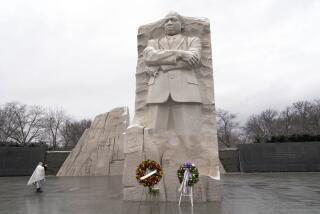Black History at Williamsburg
- Share via
WILLIAMSBURG, Va. — Deborah Downs laid the old-fashioned broom across the floor and invited the giggling kids to jump over it. “Congratulations, you’re now husband and wife,” said Downs, the hip, young African American interpreter. She was trying to teach the children about African American family traditions, 18th century Williamsburg style. Whoever jumped the highest headed the household, Downs explained. Divorce was as simple as jumping backward over the broom.
These weren’t legal attachments, she said, because most African Americans who lived here were slaves whose families--including children and parents--could be separated at the whim of their owners.
“Imagine how parents felt knowing they couldn’t protect their children. Imagine how those kids must have felt,” she said.
The kids in the group, including my 11-year-old daughter Reggie, have studied slavery in school. Yet they were clearly moved by hearing how slave families--parents and kids just like them--were forced to live.
Steven Spielberg’s much-discussed movie “Amistad,” the story of the 1839 shipboard rebellion of 53 African slaves en route from Africa, has cast a new national spotlight on slavery. And with Black History Month coming in February, there’s no better time to make sure children appreciate the key role African American families have played in this country from its beginning.
Williamsburg was one of the most important cities in the Colonies during the 18th century. Not only were African Americans half of the population, many were skilled craftsmen, cooks, personal assistants and confidants to leading legislators and businessmen.
“We’re doing more about African Americans every year,” said Christy Matthews, who oversees African American programs at Williamsburg. Visiting families can spend an evening with an actor playing the role of an elderly man named Paris, as he recalls Africa, his enslavement and how he survived. At the same time, other actors portray his memories on stage. Families can join in the dance and storytelling traditions of early African Americans or make baskets with “slave children” a few miles away at the Carter’s Grove Slave Quarter, where exhibits reflect Virginia life of the past 400 years.
Reggie and I watched a young Thomas Jefferson debate slavery with a 20th century visitor in the garden of Williamsburg’s Governor’s Palace. Jefferson argued that he abhorred the practice but felt he couldn’t free his own slaves until the laws had been changed. The 20th century visitor called that argument an excuse.
Matthews noted that programs portraying slavery as part of 18th century life will continue to expand this spring as Williamsburg revamps exhibits to make them more interactive and kid-friendly.
The good news, Christy Matthews said, is that the numbers of African Americans visiting Williamsburg has more than doubled in the past five years to 22,000, annually. The bad news is that that number still represents less than 3% of Williamsburg’s annual visitor total. Matthews said she hopes that the movie “Amistad” will help spark new interest.
We certainly were interested. We learned slave children and their owners’ children often shared games, secrets and meals in the kitchen. It was only as the children became teenagers that the relationships were forced to change.
“I’m glad it’s not like that anymore,” Reggie whispered.
We stayed at both the Woodlands Lodge, a short shuttle bus ride from the historic area, and at the more upscale and expensive Williamsburg Lodge. Comfortable, motel-style rooms overlooking the extensive grounds can be rented at the Woodlands for about $75 a night during the winter, and $120 in summer. Our kids liked the waterfall, duck pond, miniature golf, tennis and outdoor pool (closed in the winter).
In cold weather, I prefer the Williamsburg Lodge because of its indoor pool, its ambience, its convenience--half a block from the historic area and across the street from the Abby Aldrich Rockefeller Folk Art Center and its historic toy exhibit. The lodge has a large lobby with a huge fireplace, groups of deep, leather chairs and checker sets. In summer and some weekend evenings, there are special children’s activities at the lodge, as well as at the Art Center. Lodge rates start at $139 in low season and $225 in summer. Ask about special hotel-admission packages.
Basic one-day tickets cost $25 for adults and $15 for children 6 to 12. Don’t forget to reserve ahead for a meal at one of the 18th century taverns. Try Shield’s Tavern, where African American balladeers perform in summer on the tavern’s outdoor garden stage.
Taking the Kids appears the first and third week of every month.
More to Read
Sign up for The Wild
We’ll help you find the best places to hike, bike and run, as well as the perfect silent spots for meditation and yoga.
You may occasionally receive promotional content from the Los Angeles Times.






